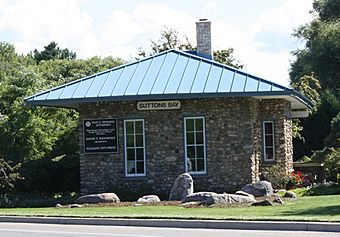Suttons Bay station facts for kids
|
Leelanau Transit Company Suttons Bay Depot
|
|
 |
|
| Location | 101 S. Cedar St., Suttons Bay, Michigan |
|---|---|
| Area | 0.1 acres (0.040 ha) |
| Architectural style | Bungalow/craftsman |
| NRHP reference No. | 97000929 |
Quick facts for kids Significant dates |
|
| Added to NRHP | August 21, 1997 |
The Leelanau Transit Company Suttons Bay Depot is an old train station. It is also known as the Suttons Bay Railroad Depot. You can find it at 101 South Cedar Street in Suttons Bay, Michigan.
This building is important because it was added to the list of Michigan State Historic Sites in 1997. It was also listed on the National Register of Historic Places in the same year.
History of the Depot
In 1903, a railroad company called the Traverse City, Leelanau, and Manistique Railroad built tracks through Suttons Bay. Their goal was to reach a special ferry that carried train cars across the water to Manistique. A few years later, they added a shorter track next to the main one, called a siding.
However, this railroad did not do well. The train car ferry stopped running by 1908. In 1919, a new company took over the tracks. This company was named the Leelanau Transit Company.
The Leelanau Transit Company rented the train line to another company, the Manistee and North-Eastern Railroad. They built this train station, or depot, in Suttons Bay. It was used for both people traveling by train (passengers) and for moving goods (freight).
In the 1960s, the train tracks north of Suttons Bay were no longer used. From 1989 to 1995, a company called the Leelanau Scenic Railroad used the tracks between Suttons Bay and Traverse City. But in 1996, the tracks were removed. A special path for walking and biking, called a rail trail, was built where the tracks used to be. Today, the old train depot is used as a law office.
What the Depot Looks Like
The Suttons Bay Railroad Depot is a one-story building. It was built in a style called Arts-and-Crafts. This style often uses natural materials and looks handmade.
The building is made from rounded cobblestones, which are like smooth, round rocks. It has a special roof called a hip roof, which slopes down on all four sides. The roof sticks out far over the edges of the building. This helps protect the walls and the platform where people waited for trains.



